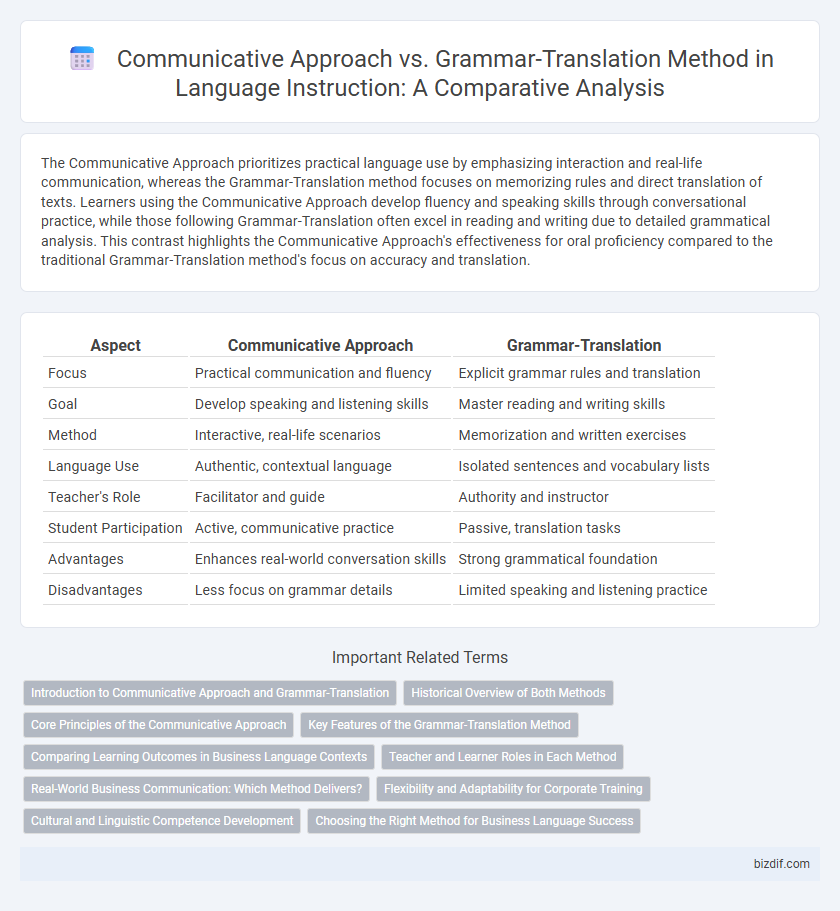The Communicative Approach prioritizes practical language use by emphasizing interaction and real-life communication, whereas the Grammar-Translation method focuses on memorizing rules and direct translation of texts. Learners using the Communicative Approach develop fluency and speaking skills through conversational practice, while those following Grammar-Translation often excel in reading and writing due to detailed grammatical analysis. This contrast highlights the Communicative Approach's effectiveness for oral proficiency compared to the traditional Grammar-Translation method's focus on accuracy and translation.
Table of Comparison
| Aspect | Communicative Approach | Grammar-Translation |
|---|---|---|
| Focus | Practical communication and fluency | Explicit grammar rules and translation |
| Goal | Develop speaking and listening skills | Master reading and writing skills |
| Method | Interactive, real-life scenarios | Memorization and written exercises |
| Language Use | Authentic, contextual language | Isolated sentences and vocabulary lists |
| Teacher's Role | Facilitator and guide | Authority and instructor |
| Student Participation | Active, communicative practice | Passive, translation tasks |
| Advantages | Enhances real-world conversation skills | Strong grammatical foundation |
| Disadvantages | Less focus on grammar details | Limited speaking and listening practice |
Introduction to Communicative Approach and Grammar-Translation
The Communicative Approach emphasizes real-life communication skills and interactive use of language, prioritizing speaking and listening over rote memorization. In contrast, the Grammar-Translation method focuses on the detailed study of grammatical rules and the translation of texts, often at the expense of speaking abilities. Both methods serve different instructional goals, with the Communicative Approach fostering practical language use and Grammar-Translation supporting literary and reading comprehension.
Historical Overview of Both Methods
The Communicative Approach emerged in the 1970s as a response to the limitations of the Grammar-Translation method, which dominated language instruction since the 19th century with its focus on rote memorization and translation of classical texts. The Grammar-Translation method prioritized grammar rules and vocabulary in written form, often neglecting speaking and listening skills, whereas the Communicative Approach emphasized real-life communication, interactive activities, and functional use of language to enhance fluency. Historical shifts in language pedagogy reflect broader educational reforms toward learner-centered instruction and practical language proficiency.
Core Principles of the Communicative Approach
The Communicative Approach centers on meaningful interaction as the primary goal of language learning, emphasizing real-life communication and functional language use over rote memorization of grammar rules typical of the Grammar-Translation method. It promotes learner-centered activities such as role-plays, interviews, and group work that foster authentic language practice in context. Core principles include prioritizing fluency and comprehension, integrating all language skills--listening, speaking, reading, and writing--and encouraging spontaneous communication to develop communicative competence.
Key Features of the Grammar-Translation Method
The Grammar-Translation Method emphasizes reading and writing skills through the direct translation of texts between the target language and the native language, focusing on grammar rules and vocabulary memorization. This method involves extensive use of bilingual dictionaries, explicit instruction in grammatical forms, and the correction of students' written exercises to develop accuracy. Communicative competence is less prioritized compared to accuracy in language structure within this traditional teaching approach.
Comparing Learning Outcomes in Business Language Contexts
The Communicative Approach enhances business language proficiency by prioritizing practical communication skills and real-world interaction, resulting in improved fluency and confidence in professional settings. In contrast, the Grammar-Translation method emphasizes grammatical accuracy and vocabulary memorization, often leading to limited conversational capability and slower adaptability in dynamic business environments. Studies indicate that learners using the Communicative Approach demonstrate higher retention of business-specific terminology and greater effectiveness in cross-cultural negotiations.
Teacher and Learner Roles in Each Method
The Communicative Approach emphasizes active learner participation, where the teacher acts as a facilitator promoting real-life communication and spontaneous language use. In contrast, the Grammar-Translation method positions the teacher as the primary authority delivering explicit grammar rules, with learners focusing largely on reading, translating, and memorizing vocabulary. These differing roles influence language acquisition, with the Communicative Approach fostering interactive fluency and the Grammar-Translation method emphasizing accuracy and written language skills.
Real-World Business Communication: Which Method Delivers?
The Communicative Approach emphasizes practical language skills crucial for real-world business communication, fostering fluency and interactive competence through role-plays and authentic scenarios. In contrast, the Grammar-Translation method prioritizes accuracy and grammatical rules, often neglecting spontaneous speaking and listening skills vital in business settings. Research indicates that professionals trained with the Communicative Approach demonstrate superior negotiation, presentation, and email correspondence abilities in global markets.
Flexibility and Adaptability for Corporate Training
The Communicative Approach offers greater flexibility and adaptability for corporate training by emphasizing real-life language use and interactive skills tailored to specific workplace needs. Unlike the Grammar-Translation method, which relies heavily on rote memorization and rigid rules, the Communicative Approach facilitates dynamic learning environments that respond to evolving corporate communication demands. This methodology supports customized training modules that enhance employee engagement and practical language proficiency in diverse professional contexts.
Cultural and Linguistic Competence Development
The Communicative Approach prioritizes cultural and linguistic competence by engaging learners in real-life communication and contextualized language use, enhancing their ability to understand and adapt to diverse cultural nuances. In contrast, the Grammar-Translation method focuses primarily on syntactic structures and vocabulary, often neglecting the pragmatic and cultural aspects of language. This results in limited proficiency in authentic communication despite strong grammatical knowledge.
Choosing the Right Method for Business Language Success
Selecting the appropriate language instruction method is crucial for business communication effectiveness, where the Communicative Approach emphasizes real-life interaction and practical usage, enhancing fluency and conversational skills. In contrast, the Grammar-Translation method focuses on grammatical accuracy and vocabulary memorization, which may limit spontaneous communication in dynamic business environments. Prioritizing the Communicative Approach aligns with business language objectives by fostering adaptable and confident speakers capable of navigating diverse professional contexts.
Communicative Approach vs Grammar-Translation Infographic

 bizdif.com
bizdif.com